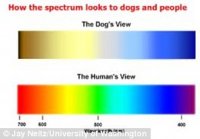migtig
aka Mrs. Giant
I've been saying it for a while:
Dogs CAN see in colour: Scientists dispel the myth that canines can only see in black and white | Mail Online
Excerpt:
There's a common misconception that dogs can only see in monochrome and use varying brightness levels to identify the outlines of items.
Yet Russian scientists have now proved not only do dogs have a limited colour range, they use this visual spectrum to distinguish between objects and select certain items from a line-up.
Excerpt:
For decades, scientists believed dogs could only see in monochrome and used brightness levels - whether something looked lighter or darker next to another object - to identify outlines of items.
However, last year scientist Jay Neitz from the University of Washington, carried out experiments on dogs to test this theory.
Human eyes have three 'cones' that detect colour and can identify red, blue, green and yellow wavelengths created by light entering the eye.
Neitz discovered that dogs only have two cones - this means they can distinguish blue and yellow, but not red and green.
This is the same spectrum seen by humans when they have colourblindness.
Dogs CAN see in colour: Scientists dispel the myth that canines can only see in black and white | Mail Online
Excerpt:
There's a common misconception that dogs can only see in monochrome and use varying brightness levels to identify the outlines of items.
Yet Russian scientists have now proved not only do dogs have a limited colour range, they use this visual spectrum to distinguish between objects and select certain items from a line-up.
Excerpt:
For decades, scientists believed dogs could only see in monochrome and used brightness levels - whether something looked lighter or darker next to another object - to identify outlines of items.
However, last year scientist Jay Neitz from the University of Washington, carried out experiments on dogs to test this theory.
Human eyes have three 'cones' that detect colour and can identify red, blue, green and yellow wavelengths created by light entering the eye.
Neitz discovered that dogs only have two cones - this means they can distinguish blue and yellow, but not red and green.
This is the same spectrum seen by humans when they have colourblindness.


